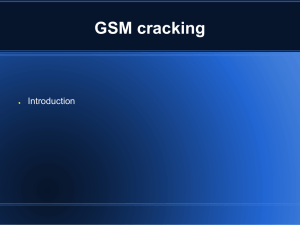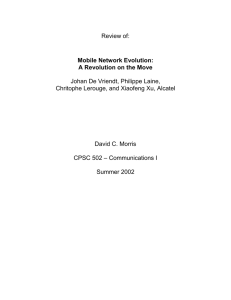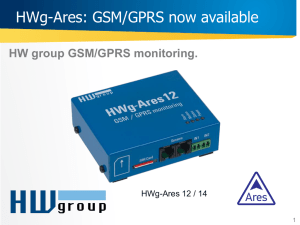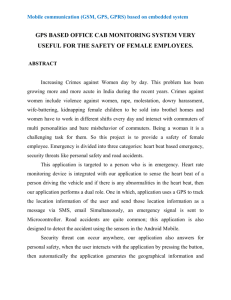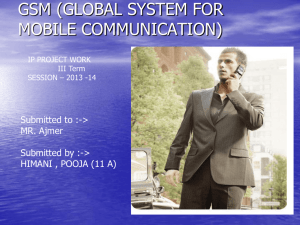Feasibility study of secure speech and data over GSM voice channel
advertisement
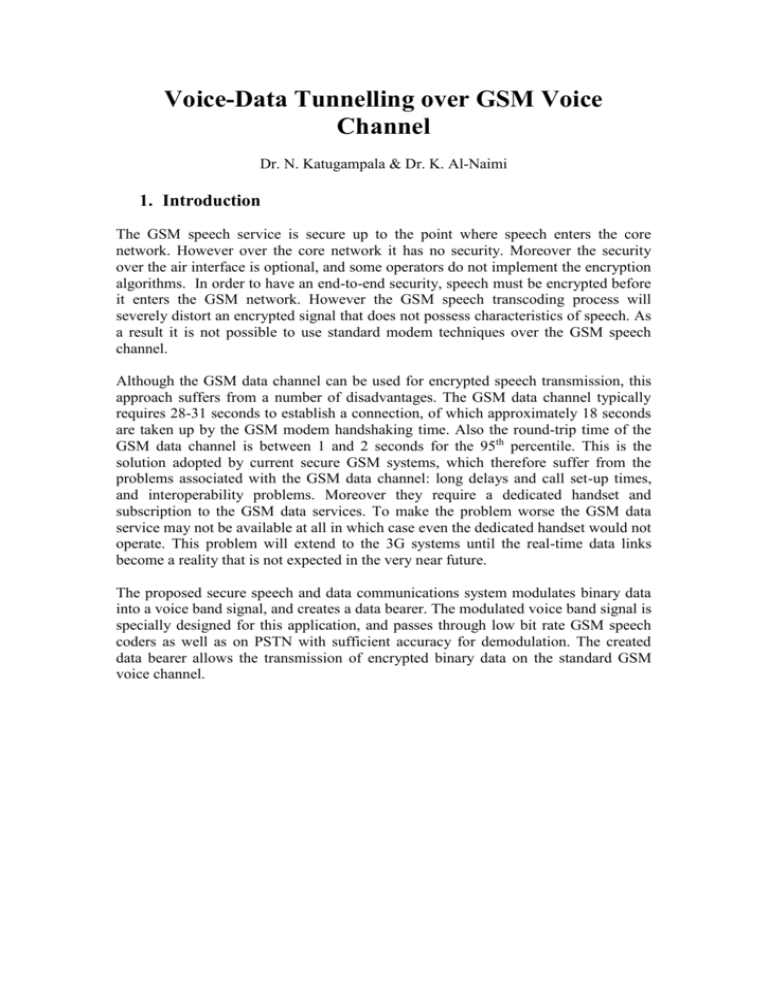
Voice-Data Tunnelling over GSM Voice Channel Dr. N. Katugampala & Dr. K. Al-Naimi 1. Introduction The GSM speech service is secure up to the point where speech enters the core network. However over the core network it has no security. Moreover the security over the air interface is optional, and some operators do not implement the encryption algorithms. In order to have an end-to-end security, speech must be encrypted before it enters the GSM network. However the GSM speech transcoding process will severely distort an encrypted signal that does not possess characteristics of speech. As a result it is not possible to use standard modem techniques over the GSM speech channel. Although the GSM data channel can be used for encrypted speech transmission, this approach suffers from a number of disadvantages. The GSM data channel typically requires 28-31 seconds to establish a connection, of which approximately 18 seconds are taken up by the GSM modem handshaking time. Also the round-trip time of the GSM data channel is between 1 and 2 seconds for the 95th percentile. This is the solution adopted by current secure GSM systems, which therefore suffer from the problems associated with the GSM data channel: long delays and call set-up times, and interoperability problems. Moreover they require a dedicated handset and subscription to the GSM data services. To make the problem worse the GSM data service may not be available at all in which case even the dedicated handset would not operate. This problem will extend to the 3G systems until the real-time data links become a reality that is not expected in the very near future. The proposed secure speech and data communications system modulates binary data into a voice band signal, and creates a data bearer. The modulated voice band signal is specially designed for this application, and passes through low bit rate GSM speech coders as well as on PSTN with sufficient accuracy for demodulation. The created data bearer allows the transmission of encrypted binary data on the standard GSM voice channel. 2. Architecture of the proposed system Speech-like waveform 1100110 Data encryption Speech encoder Input speech 1010101 Data modulator Add-on module to be connected to standard GSM handset Speech encoder PSTN to GSM Speech decoder GSM to PSTN 64 kbps PCM waveform Base Station Subsystem Base Station Subsystem Speech-like waveform 1010101 Data demodulator 1100110 Data decryption Speech decoder Output speech Add-on module to be connected to standard GSM handset Figure 1: Block diagram of the prototype system Figure 1 depicts the block diagram of the prototype system. The major blocks of the system are the speech codec, data encryption/decryption, and data modem. All the functions can be implemented in software to run on a suitable hardware such as a PDA, an embedded PC, or an integrated PDA/GSM handset. The interfaces between the functions are provided by shared software buffers. When implemented as an addon module the connection with the GSM handset can be provided by either cable or Bluetooth. A cable connection to the handsfree socket of the phone provides an analogue interface. Alternatively a Bluetooth connection provides a digital interface. 3. Experimental results over real GSM voice channels Experiments were carried out on typical GSM channel conditions, which did not exhibit unusual frame erasures patterns. The extreme conditions e.g. inside the tunnels etc. were not tested. A cable was used as to connect a standard Nokia handset and the modem at each end, i.e. an analogue interface. The modem was implemented in software on a standard PC. A digital interface using Bluetooth is expected to give at least as good results if not better. The gross rate of the modem is 3 kbps at 6% BER. The modem which includes a 1:2 convolutional coder provides a throughput of 1.2 kbps at 0.35% BER, and 1% FER. The SBLPC speech coder operating at 1.2 kbps is capable of withstanding those error rates, without degrading the speech quality. The modem signal is capable of maintaining a continuous data channel despite the GSM VAD, and withstands the effects of the various filters, which are present in the GSM transmission chain. Setting up delay is less than 500 ms, and end-to-end delay is less than 200 ms, which includes the delay of the GSM voice channel. The experiments were carried out for the worst-case scenario i.e. GSM to GSM channels, and GSM to PSTN channels are expected to provide better performance. An experimental blue-tooth connection on the transmitter end (which avoids the analogue section of the phone) indicates that close to 0% BER is achievable at 1.2kb/s source rate. At present PC based prototype is being configured for real-time measurements and a patent covering the new invention is being processed.

